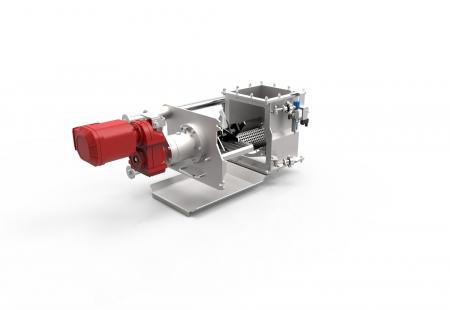Various mechanisms are used in industry to reduce particles and powders. Each of these machines is suitable for certain types of products and the fineness of the powder particles to be achieved. Also elastic and tough products such as wood and paper can be converted into smaller parts. This article discusses a number of types of machines that are used to reduce particles, granular products and fiber-rich materials. The devices addressed are:
- The operation of a breaker
- The operation of a crusher
- The operation of a hammer mill
- The operation of a ball mill
- The operation of a disc mill
- The operation of a pin mill
The operation of a pulper, shredder, meat slicer, meat grinder, roll mill and crumbler are shown in the article: Machines for comminuting materials - part 2.
De experts van Dinnissen Process Technology staan klaar voor al uw vragen:
Get in touch with Juul Jenneskens 077 467 3555
The operation of a chopper
A chopper is a machine that rotates sharp knives at high speed in a storage bin. The reduction is done by means of shear forces. The speed of a chopper is adjustable. In addition, the box must be shielded for safety. The Dutch term for this appliance is “chopper”, but for household use the name “blender” is almost always used.
In the household, the chopper is generally used to purée and mix liquids together with fruit and / or vegetables. The chopper is also used in the food processing industry to produce food products. The chopper is especially suitable for elastic and tough materials. An end product can be produced with a medium to ultra fine finish.

A breaker reduces chunks by impulse forces
The operation of a crusher
A crusher is a machine that can shred large lumps, clods and agglomerates into smaller parts based on impulse forces. Originally this machine was used to break rocks and generate smaller boulders, gravel or rock dust and mortar. Today, crushers are used to shred or change the shape of substances for further processing or recycling. The crusher is also used in the food industry, for example for crushing cocoa cake, filter cake, frozen fruit, cinnamon sticks and clumped products.
The crusher operates on the rotor / stator principle, in which the product is reduced by cams on a central shaft, in combination with stator combs mounted in the housing. The low rotational speed of the crusher makes it possible to process large amounts of material with low energy consumption. Due to the low heat development, the crusher is able to crush moist and fatty products, such as raw materials for the food industry. This makes the crusher usable for large, hard materials and for elastic and tough materials with a fibrous structure. The end product that is delivered can vary from smaller debris to granules of a few millimeters and dust particles. For applications where fine powders have to be generated, a sieve system consisting of several sieves is mounted under the rotor.
The operation of a hammer mill
A hammer mill is a machine that can deform sticky materials into smaller small ones by impulsive forces. The grinding room is centrally located in the hammer mill. Several hammers rotate quickly in it. The coarse material fed into the grinding chamber collides with the rotating hammers and is beaten into small pieces. A sieve is mounted under the hammer mechanism. As soon as the product has reached the desired fineness, it leaves the grinding space through the sieve. The capacity and particle size depend on several factors:
- The configuration includes the number of hammers, the length of the hammers and the distance from the screen plate, the distribution of the hammers and the width of the hammers.
- The speed in combination with the length of the hammers has an influence on the capacity and product fineness.
- The hammer speed. A higher speed of the hammers causes a greater impact on the product. This leads to a product with a higher fineness and a higher capacity.
- The amount of air through the hammer mill has an influence on the capacity and fineness. More air through the mill results in a higher capacity and a larger product. A larger air flow has the side effect of creating greater cooling.
- The sieve plates influence the capacity and the particle size. Smaller holes in the sieve and / or a thicker sieve plate yield a finer product but a smaller capacity. A smaller pitch and / or the application of grating plates produces more capacity and a coarser product.
Various types of hammer mills are available for the different application areas. For example, there are hammer mills that are extra robust and equipped with a more powerful drive. In this way they are suitable for the somewhat coarser breaking work. A hammer mill is versatile. It is possible to grind brittle and crystalline materials and hard and abrasive products. The hammer mill must be hygienically designed for crushing products in the food industry. The hammer mill must be easy to clean and suitable for inspection. In the food industry, different foods are processed with different properties. It is therefore important that the hammer setting can be adjusted and the screens can be easily changed.

A hammer mill crushes sticky particles by impulse forces
Discs and pins can be designed in various shapes so that optimum processing can be achieved for every product and application
The operation of a ball mill
A ball mill is used to grind powders or granular materials or to mix suspensions based on impulse forces. A suspension is a mixture of two substances of which one substance consists of very small particles and is mixed with another substance. Often these are solids that are mixed in a liquid. Ball mills are used, among other things, in the chemical industry and the paint industry, or for the production of fireworks.
The working principle of a ball mill is based on a hollow cylinder with rotating balls. The cylinder is made of wear-resistant material. As soon as the cylinder is filled with raw material, the moving balls will start the grinding and mixing process. In industrial ball mills, the cylinder generally stands still and the balls are set in motion by a rapidly rotating rotor. After processing in the ball mill, the end product has a fine to ultra-fine fineness.
The operation of a disc mill
A disc mill is a shear grinding machine. Many applications and operations are used in disc mills. The principle of a disc mill is based on a rotating disc, grooved at the bottom, above a flat plate. The product to be ground is located between the disc and the plate, which product is simultaneously carried along and crushed by the rotating disc. This type of grinder is called a single disc grinder. More effective are the double disc mills in which the grinding takes place between two discs rotating in opposite directions. The disc mills impart a medium to ultra fine fineness to the processed product.
A single-disc grinder is used in maize grinding, peanut butter production, processing chemicals such as ammonium nitrate and urea, and producing chemical slurries and chrome metal grinding.
A double disc grinder is used for many applications such as aluminum chips, bark, barley, borax, brass chips, sodium hydroxide and chemical salts. Disc mills are more expensive than other mills because of the higher investment and maintenance costs. They are therefore only used where other types of mills do not yield the desired result.
The operation of a pin mill
A pin mill is a crusher that can reduce materials by means of impulse forces. Pin mills are used for processing dry materials as well as for comminuting and mixing liquid suspensions. Pin mills are particularly suitable for the manufacture of pharmaceuticals, as they can achieve particle sizes of just a few micrometers. The principle of a pin mill is based on the operation of a kitchen mixer. A mechanism causes a number of pins to repeatedly move past each other through the material to be comminuted. Due to the repeated impact, the material breaks into pieces. The pins are mounted on two discs with the pins facing each other. There are pin mills where one disc rotates and the other disc does not move. It is also possible for both discs to rotate. This rotational speed is adjustable. The pins are positioned so that they do not touch each other during rotation, but move close to each other. The substance to be mixed and ground is in the grinding chamber. This is the space between the discs and the pins. The material is fed into the grinding chamber evenly by the feeding system, greatly affected by the fast rotating disc. At the same time, it is subjected to various extensive forces such as friction, shear and collision between the static disc and the ring gear to grind material. The moving disc and the static disc can be combined in different structural shapes depending on the nature of the material to meet the grinding requirements of different materials. In addition, the discs and pins can be designed in various shapes, so that optimum processing can be achieved for every product and application.

Name: Juul Jenneskens
Advisor
Please feel free to contact me if you have any questions about this subject. My team of colleagues and I are ready to answer!
Get in touch with Juul Jenneskens 077 467 3555 [email protected]
Do you prefer to request a consultation directly?
